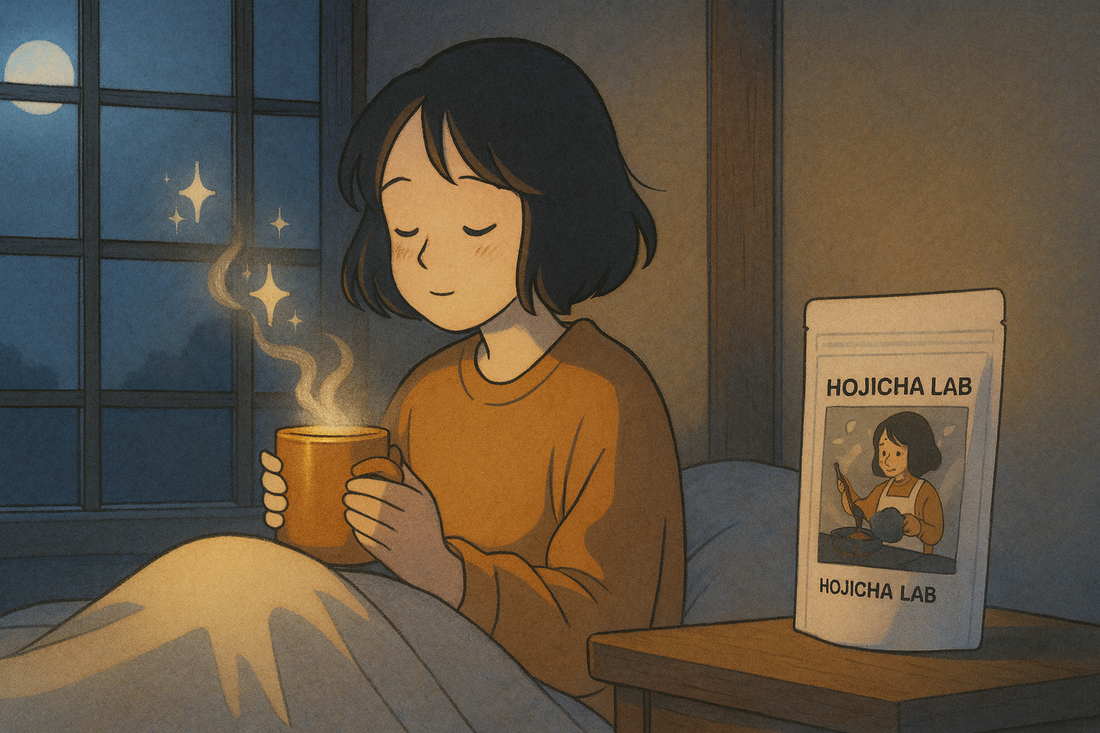
Hojicha Benefits: A Gentle, Low-Caffeine Ritual for Calm Focus
Low Caffeine Lifestyle
Hojicha is typically made from later-season green tea leaves, stems, or bancha that are gently roasted. That process, combined with the leaf material used, often results in a brew that’s naturally lower in caffeine than coffee, matcha, or many black teas. For people who love the ritual of a warm cup but prefer a softer lift, hojicha can feel like the sweet spot: enough to accompany work, reading, or study — without tipping into jitters.
Because caffeine content varies with leaf grade, water temperature, and steep time, the most helpful approach is practical: brew a cup, notice how you feel, and adjust strength to suit your day. Many tea drinkers also use hojicha to bridge the afternoon — swapping one coffee for a roasted tea latte to keep focus even and sleep intact.
Antioxidants in Roasted Green Tea (Balanced View)
Green teas are known for polyphenols (such as catechins). When hojicha is roasted, its profile changes — some compounds decrease, others transform, and new aroma molecules appear, bringing those toasted, caramel-like notes. The end result is still a tea that contributes antioxidants as part of an overall varied diet, just with a flavour and character distinct from steamed green teas.
It’s helpful to think less in terms of “more” or “less” benefit and more about different benefit: roasted teas offer an appealing way to drink more unsweetened liquids through the day, while adding variety to your cup. If you already love green tea but sometimes want something mellower and cosier, hojicha is a natural rotation option.
Digestion & Cosy Warmth (Non-Medical)
Warm beverages can feel soothing — especially after meals or on cooler evenings. Hojicha’s gentle roast and low bitterness make it easy to sip slowly without milk or sugar, supporting an overall intention to reduce overly sweet drinks. Many people also enjoy a simple hojicha latte: whisk powder with a splash of hot water, then top with warm milk (dairy or plant-based) for a silky, dessert-adjacent treat that’s still relatively light.
None of this is medical advice; it’s about comfort and habit. If a cosy cup helps you unwind, it may be worth building into your routine.
Habit Stacking: A Mindful Evening Wind-Down
Hojicha works beautifully as the anchor for a short, repeatable wind-down ritual. Try this 5-minute sequence:
- Boil, then breathe: heat the kettle; while it warms, take 3 slow breaths.
- Whisk & pour: whisk 1–2 teaspoons of hojicha powder with a dash of hot water; top with water or warm milk.
- Phone-off minute: set your device aside; notice aroma, steam, and taste.
- Light stretch or journalling: just two lines of gratitude or a gentle shoulder roll.
By pairing tea with one small wellbeing action, you create a cue that signals “day is slowing down”. Over time, that cue can make transitions — from work mode to home mode, from screens to sleep — more intentional.
Who might enjoy it
- Students: a steady, lower-caffeine study companion for late seminars and revision.
- New mums: a cosy cup for quiet moments, with caffeine on the gentler end.*
- Busy professionals: an evening ritual that feels indulgent but light.
*Caffeine needs vary. If you’re pregnant, breastfeeding, or sensitive to caffeine, seek personalised guidance from a qualified professional.
Approximate Caffeine Comparison
Exact caffeine depends on leaf grade, serving size, brew strength, and brand. These broad ranges are for typical home preparation:
| Beverage | Typical Serving | Approx. Caffeine |
|---|---|---|
| Filter coffee | 240 ml cup | ~80–120 mg |
| Black tea | 240 ml cup | ~40–70 mg |
| Matcha | 1–2 g powder (tea) | ~60–80 mg |
| Hojicha | 240 ml cup (loose-leaf) or 1–2 tsp powder | ~7–20 mg (loose-leaf)† / variable (powder) |
†Stems/bancha-based hojicha tend to brew lower; powder strength varies with how much you use. Adjust to taste and timing.
FAQ
Is hojicha safe to drink daily?
Many people enjoy hojicha daily as part of a balanced diet and hydration routine. If you monitor your overall caffeine intake and feel good with it, a daily cup (or two) can fit comfortably for a lot of lifestyles. If you have a specific condition or sensitivity, seek personalised advice.
What about pregnancy or breastfeeding?
Caffeine guidance during pregnancy and breastfeeding is individual. Please speak with your midwife, GP, or another qualified health professional before making changes. They can help you decide on an approach that fits your needs.
Is hojicha hydrating?
Yes — like other teas prepared with water and consumed without excess sugar, hojicha contributes to your daily fluid intake. If you prefer milk lattes, that still counts towards hydration while adding flavour and texture.
Does roasting destroy the benefits?
Roasting changes the tea’s profile rather than “removing” value. Some compounds decrease, others transform, and you still get a brewed drink that contributes polyphenols as part of a varied diet — with the added pleasure of a toasty, caramel-leaning flavour.
Friendly disclaimer: This article is for general wellness information only and is not medical advice. If you have questions about caffeine, pregnancy, breastfeeding, medications, or specific health concerns, please consult a qualified professional.
Written in UK English • Balanced, no-claims guidance • Enjoy mindfully.